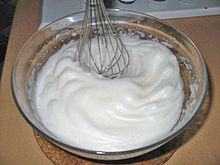This article is about the dessert. For the Haitian folk music, see Méringue. Not to be confused with Merengue.
Meringue (/məˈræŋ/ mə-RANG,[1] French: [məʁɛ̃ɡ]i) is a type of dessert or candy, traditionally made from whipped egg whites and sugar, and occasionally an acidic ingredient such as lemon, vinegar, or cream of tartar. A binding agent such as salt, flour or gelatin may also be added to the eggs. The key to the formation of a good meringue is the formation of stiff peaks by denaturing the protein ovalbumin (a protein in the egg whites) via mechanical shear.
They are light, airy and sweet confections. Homemade meringues are often chewy and soft with a crisp exterior, while many commercial meringues are crisp throughout. A uniform crisp texture may be achieved at home by baking at a low temperature (80–90 °C or 176–194 °F) for an extended period of up to two hours.

The Oxford English Dictionary states that the French word is of unknown origin. The name meringue for this confection first appeared in print in François Massialot's cookbook of 1692.[2] The word meringue first appeared in English in 1706 in a translation of Massialot's book. The first documented recipes recognizable as meringues are found in two considerably earlier 17th-century English manuscript books of recipes which give instructions for confections called "white biskit bread" in the book of recipes written in 1604 by Elinor Fettiplace (c. 1570 – c. 1647) of Gloucestershire[3] and called "pets" in the manuscript of collected recipes written by Lady Rachel Fane (1612/13 – 1680) of Knole, Kent.[4] Slowly baked meringues are still referred to as "pets" in the Loire region of France due to their light and fluffy texture.[5]
Meringues were traditionally shaped between two large spoons, as they are generally at home today. Meringue piped through a pastry bag was introduced by Antonin Carême.[6]
There are several types of meringue: the sweetened, beaten egg whites that form the "islands" of floating island (also known in French as île flottante); the partly cooked toppings of lemon meringue pie and other meringue-topped desserts; and the classic dry featherweight meringue. Different preparation techniques produce these results.
Protein distribution in egg whites is as follows: (54%) ovalbumin, (13%) conalbumin/ ovotransferrin, (11%) ovomucoid, (4%) ovoglobulins, (3.5%) lysozyme, and (2%) ovomucin.[7] Ovoglobulins drive foaming, ovomucin is the main stabilization agent, and the remainder of the proteins interact to contribute to overall foaming and stability. When egg whites are beaten, some of the hydrogen bonds in the proteins break, causing the proteins to unfold ("denature") and to aggregate non-specifically. When these egg white proteins denature (due to agitation from beating), their hydrophobic regions are exposed and the formation of intermolecular protein-protein interactions is promoted. These protein-protein interactions, usually disulfide bridges, create networks responsible for the structure of the foam and this change in structure leads to the stiff consistency required for meringues. The use of a copper bowl, or the addition of cream of tartar is required to additionally denature the proteins to create the firm peaks, otherwise the whites will not be firm.[citation needed] Wiping the bowl with a wedge of lemon to remove any traces of grease can often help the process.

When beating egg whites, they are classified in three stages according to the peaks they form when the beater is lifted: soft, firm, and stiff peaks.
Egg whites and sugar are both hygroscopic (water-attracting) chemicals. Consequently, meringue becomes soggy when refrigerated or stored in a high-humidity environment.[8] This quality also explains the problem called "weeping" or "sweating", in which beads of moisture form on all surfaces of the meringue.[8] It can also happen if the meringue is undercooked (resulting in a puddle of liquid under the meringue) or overcooked (resulting in beading on top).[8] Sweating is a particular problem for French meringues in which the granulated sugar is inadequately dissolved in the egg whites, and for high-moisture pie fillings.
